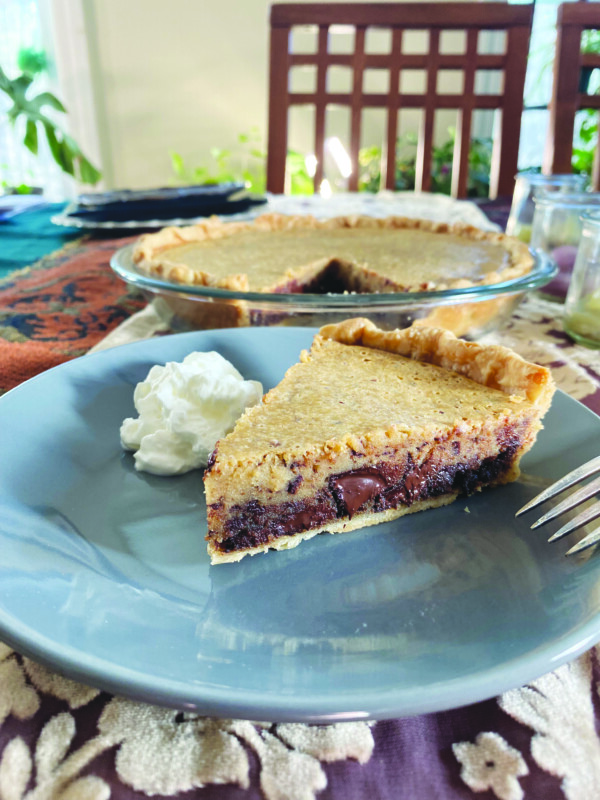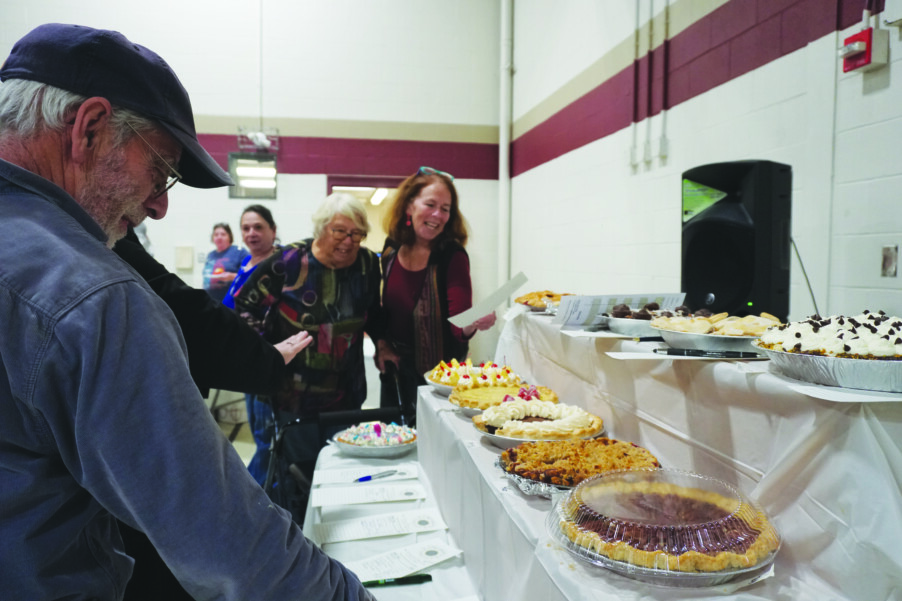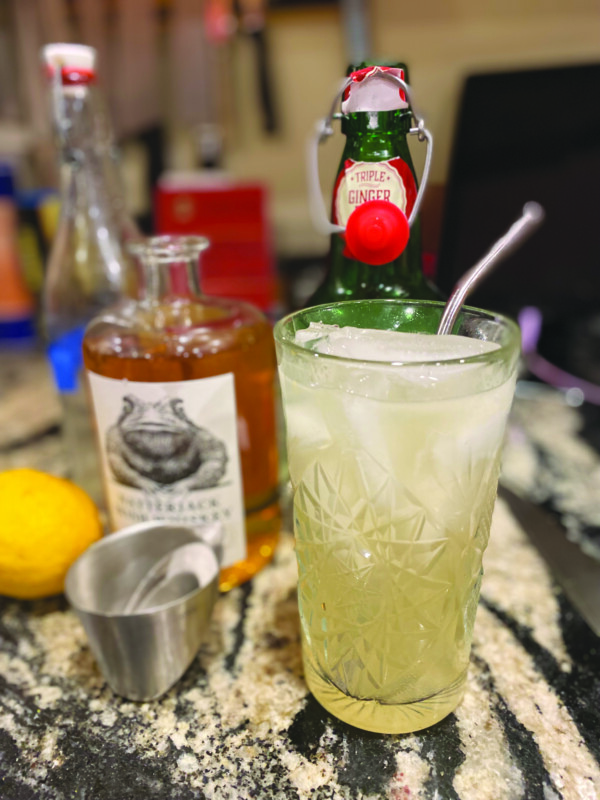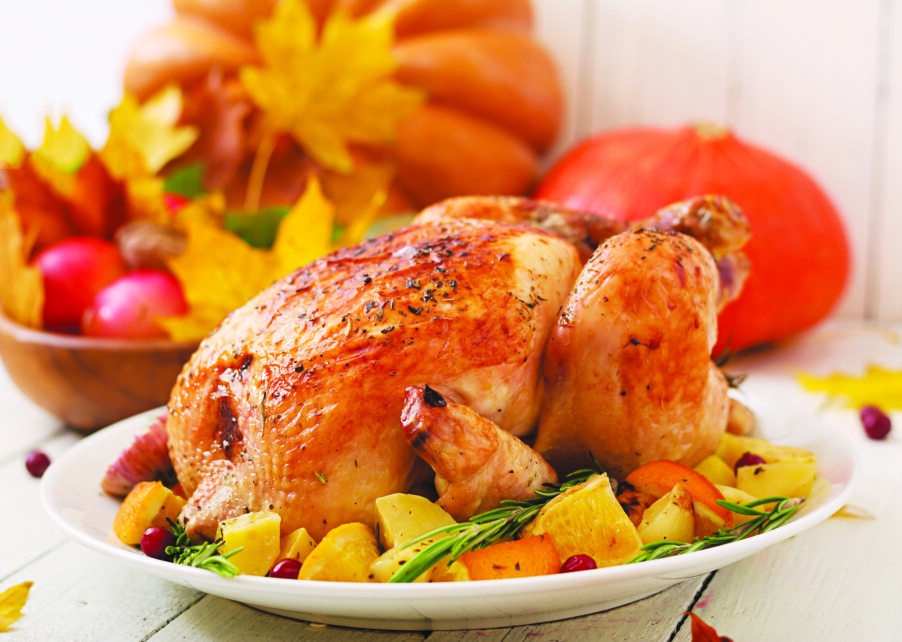Where to get pies, sides and the gravy
By John Fladd
[email protected]
Here are some of the spots offering dessert, sides and sometimes even the whole turkey dinner to go. Know of a place not mentioned here? Let us know at [email protected].
• All Real Meal (87 Elm St., Manchester, 782-3014, allrealmeal.com) is taking orders on its website for Thanksgiving dinner that include turkey, gravy, mashed potatoes, stuffing, green beans and cranberry with the option of an individual size, a meal to serve three to four people or a meal to serve six to eight people. Sides, gluten-free stuffing and desserts are also available. Visit the website to see which towns are eligible for free delivery.
• Angela’s Pasta and Cheese Shop (815 Chestnut St., Manchester, 625-9544, angelaspastaandcheese.com) is taking orders until Wednesday, Nov. 20, at 4 p.m. (prepay only). On the menu are traditional Thanksgiving dinner items, from turkey ( $39.95) to cranberry relish ($6.95), sweet pies ($18.95 to $33.95), pork pie, ($21.95), and a full selection of baked goods and desserts. Orders will be available for pickup on Wednesday, Nov. 22, between 10 a.m. to 6 p.m. Pick up orders on Wednesday, Nov. 27, from 10 a.m. to 6 p.m.
• Applecrest Farm Orchards (133 Exeter Road, Hampton Falls, 926-3721, applecrest.com) is offering Thanksgiving food to take home for the holiday, including pies and crisps, cider and doughnuts, fresh baked goods, fresh turkeys and homemade sides. Turkeys are available for pickup anytime during farm stand hours Monday, Nov. 25, through Wednesday, Nov. 27, and Thursday, Nov. 28, from 8 a.m. to 1 p.m. Order through the farm’s website.
• Apple Hill Farm (580 Mountain Road, Concord, 224-8862, applehillfarmnh.com) offers a variety of pies (apple, apple crumb, blueberry, blueberry crumb, cherry, cherry crumb, maple custard, strawberry rhubarb, strawberry rhubarb crumb, pumpkin, mince and pecan) and is taking orders until Monday, Nov. 25. Shaker-style squash rolls and Parker House rolls are also available for special orders. Call the stand to place your order. Pick up orders Monday, Tuesday or Wednesday of Thanksgiving week until 5:30 p.m. Wednesday, Nov. 27, will be the last day of Apple Hill’s 2024 season.
• Atlantic Grill (5 Pioneer Road, Rye, 433-3000, theatlanticgrill.com) is taking Thanksgiving dinner orders now through Saturday, Nov. 18, to be picked up on Wednesday, Nov. 27. Main courses feed six to eight people and are $199. Order online.
• The Bakeshop on Kelley Street (171 Kelley St., Manchester, 624-3500, thebakeshoponkelleystreet.com) offers a variety of baked goods such as homemade doughnuts, made-to-order cakes, cupcakes, pastry trays and specialty desserts. New for this year, there is a Black Forest Cherry Pie and a White Chocolate Cream Pie. Half pies are available, and also half and half (half one flavor, half another). The last day for ordering is Thursday, Nov. 21. Pickup hours are Tuesday, Nov. 26, and Wednesday, Nov. 27, between 8 a.m. and noon.
• Barrel and Baskit (377 Main St., Hopkinton, 746-1375, barrelandbaskit.com), the expanded location of Local Baskit meal kits, is offering a full catering menu of prepared sides, the popular Beautiful Brussels Sprouts meal kit side dishes, pies and dessert platters, antipasto and charcuterie platters as well as soups and prepared vegan butternut squash stuffed shells to complete Thanksgiving for all your guests. Preorder online by Friday, Nov. 22, or stop in to the store for wine, beer and additional grab-and-go items. Visit barrelandbaskit.com.
• Bearded Baking Company (819 Union St., Manchester, 647-7150, beardedbaking.com) is offering a full range of holiday baked goods for Thanksgiving, including: Lambeth and carrot cakes, apple or blueberry crumb, pecan, lemon meringue, and chocolate pies, festive breads and vegan cookies. Pick up orders between 8 a.m. and 4 p.m. on Tuesday, Nov. 26, or Wednesday, Nov. 27.
• The Big Bad Food Truck (Hampton, bigbadnh.com) is offering a turkey dinner package enough to feed six to eight people that includes one turkey, a pint of gravy, one quart of baby carrots, a half pan of cornbread stuffing and half pan of mashed potatoes for $135. There is also a brisket dinner package that feeds six to eight people that includes 10 to 12 pounds of smoked Angus brisket, a half pan of mac & cheese, a half pan of whipped Yukon potatoes, a quart of sweet coleslaw and a pint of brown sugar and rum barbecue sauce, for $240. All orders can be picked up at 41 Ashworth Ave. in Hampton between 3 and 7 p.m. on Monday, Tuesday or Wednesday prior to Thanksgiving. You can choose your preferred date from the drop-down menu when you order online. Orders close on Nov. 21.
• The Black Forest Cafe and Bakery (212 State Rte 101, Amherst, 672-0500, theblackforestnh.com) has its Thanksgiving menu available on its baking website, and will offer its normal catering menu, as well as some specialty items. Orders will be accepted through Sunday, Nov. 24, and can be picked up through 12 p.m. on Thanksgiving Day, Thursday, Nov. 28.
• Brookdale Fruit Farm (41 Broad St., Hollis, 465-2240, brookdalefruitfarm.com) is taking orders for pies. Apple, apple crumb, blueberry and pumpkin pies are $21.49, and triple-berry pies are $24.99. Order by phone, and pick up orders by 3 p.m. on the date specified at the time of the order.
• Brookford Farm (250 West Road, Canterbury, 742-4084, brookfordfarm.com) will help you fill your table this Thanksgiving, with locally sourced products such as apple pies, apples, pears, rolls and stuffing from Orchard Hill Bread. There is plenty of winter squash, 100 percent grass-fed dairy and more. Stock your freezer during the Farm’s bulk beef sale: orders are being taken for 100 percent grass-fed half-cows.
• Brothers Butcher (8 Spit Brook Road, Nashua, 809-4180, or 142 Lowell Road, Hudson, 577-1130, brothers-butcher.com) is taking online orders for fresh turkey, fresh free-range turkey, sausage & herb stuffing, traditional bread stuffing, garlic mashed potatoes, butternut squash, turkey gravy, and apple, pumpkin and chocolate cream pies. Visit brothers-butcher.com/Thanksgiving.
• Buckley’s Bakery and Cafe (436 DW Highway, Merrimack, 262-5929, buckleysbakerycafe.com) and Buckley’s Market and Cafe (9 Market Place, Hollis, 465-5522) are taking orders now until Friday, Nov. 22, for cakes — caramel spice cake ($46), Boston cream pie ($42), chocolate mousse cake (GF) ($48), apple crisp cheesecake ($48) — and pies — apple, pumpkin, pecan, streusel-topped blueberry crisp, and chocolate cream ($22 each), and more. Visit the Buckley’s website for a full menu.
• Caroline’s Fine Food (132 Bedford Center Road, Bedford, 637-1615, carolinesfood.com) is taking orders now through Friday, Nov. 22, at 5 p.m. for turkey ballotine with herb stuffing that serves eight to 10 people ($100) and sides such as herb-roasted sweet potatoes ($43), sausage stuffing ($60) and carrot confit ($60) that each serve 10. Cranberry sauce can be ordered by the pint ($27) or the quart ($43) as can turkey gravy ($32 for a pint, $49 for a quart.) Pick up your order on Wednesday, Nov. 27, from 11 a.m. to 3 p.m.
• Castleton Banquet and Conference Center (58 Enterprise Drive, Windham, 898-6300, castletonbcc.com) has two dinner packages available to go. The first dinner package serves 10 to 12 guests and includes a 16- to 20-pound turkey with Castleton’s bread stuffing, two quarts of homestyle mashed potatoes, butternut squash and turkey gravy, a pint of homemade cranberry relish, 12 dinner rolls and one 10-inch apple, pecan, pumpkin or blueberry pie and costs $289. The second package serves 10 to 12 guests and includes an 8- to 10-pound spiral glazed ham, two quarts of homestyle mashed potatoes and butternut squash, a quart of pineapple raisin sauce, 10 dinner rolls and the same choice of pies, for $210. All sides are also available separately, as are red and white wines. All orders must be placed by noon on Friday, Nov. 22, and pickups will be scheduled on Wednesday, Nov. 27, between 9 a.m. and noon.
• Chez Vachon (136 Kelley St., Manchester, 625-9660, chezvachon.com) is offering a variety of 9-inch pies for $14.99 including chocolate, banana, brownie, coconut, pistachio, lemon chiffon, Key lime, chocolate mousse, apple crisp, blueberry, cherry, lemon meringue, cranberry walnut, Canadian sugar pie, pumpkin, pumpkin deluxe and pumpkin mousse. Pork pie ($21) and salmon pie ($23) are available as well as cream cakes such as chocolate, cookies and crème, pistachio, strawberry, pumpkin, and apple spice each for $23.99. Please order at least 24 hours in advance. Pick up orders no later than Wednesday, Nov. 27, between 8 a.m. and 2 p.m.
• The Coach Stop Restaurant & Tavern (176 Mammoth Road, Londonderry, 437-2022, coachstopnh.com) is taking orders for takeout and delivery within a 5-mile radius on Thanksgiving Day with the last delivery and takeout being at 3:30 p.m. All entrees include turkey soup, apple cider, mashed potato, homemade bread stuffing, yams, cranberry sauce, butternut squash, baby pearl onions and green peas, hot rolls, sweet bread, homemade pie, and coffee. All entrees are $42.
• Colby Hill Inn (33 The Oaks, Henniker, 428-3281, colbyhillinn.com) is offering a takeout service available on Wednesday, Nov. 27, from 4 to 7 p.m. and Thursday, Nov. 28, until 1 p.m. Entrees include cider-brined turkey with herbed cornbread stuffing, cranberry chutney and giblet gravy, crispy porchetta (Tuscan roast pork loin), four-grain risotto with mushroom and parsnip ragout and cherry wood roasted salmon. All are served with whipped potatoes, roast sweet potatoes and fall vegetable succotash. Freshly baked pumpkin pie, sea salt caramel and pecan chocolate cake, apple crisp with vanilla gelato, sorbet duo or ricotta cheesecake are offered for dessert. The cost is $65 per person. Orders should be placed by Tuesday, Nov. 26.
• The Common Man (Lago, 1 Route 25, Meredith, 279-2253; Camp, 298 DW Highway, Meredith, 279-3003; Lakehouse, 281 DW Highway, Meredith, 279-5221; 60 Main St., Ashland, 968-7030; 10 Pollard Road, Lincoln, 745-3463; 88 Range Road, Windham, 898-0088; 1 Gulf St., Concord, 228-3463; 304 DW Highway, Merrimack, 429-3463; 21 Water St., Claremont, 542-6171; 231 Main St., Plymouth, 536-2764; 752 Route 104, New Hampton, 744-0120; 61 Laconia Road, Tilton, 286-2204; 2280 Brown Ave., Manchester, 623-5040; thecman.com) is taking orders until Friday, Nov. 22. On the menu is oven roasted turkey with house-made pan gravy, whole-berry cranberry sauce, signature stuffing, country mashed potatoes, maple roasted butternut squash, garlic green beans, dinner rolls and butter, sweet bread and a slice of pumpkin pie with cinnamon whipped cream. A meal for four is $119.95 plus tax and a meal for one is $30.95 plus tax. Other meal enhancements include glazed ham and macaroni and cheese. House baked pies can be bought individually and cost $16.95 for apple pie, $20.95 for pecan pie and $14.95 for pumpkin pie. Orders must be picked up on Wednesday, Nov. 27.
• Concord Food Co-op (24 S. Main St., 225-6840, concordfoodcoop.com) is selling fresh turkeys and complete meals to serve eight to 10 people with a 12- to 15-pound turkey, turkey gravy, roasted garlic mashed potatoes, homemade cranberry sauce, stuffing and apple roasted green beans starting at $279.99. Extra sides are also available. Brioche rolls are $9.99 a dozen. Individual meals with sides and rolls are $29.99. Call the Co-op to place your order. All orders must be placed no later than noon on Monday, Nov. 18. Prepared meals are available for pickup from 10 a.m. to 6 p.m. on Wednesday, Nov. 27. Credit cards are required for all orders. For a full refund, cancellations must be made by 5 p.m. on Monday, Nov. 18.
• Place your order with Copper Kettle To Go (39 Main St., Wilton, 654-2631, copperkettletogo.com) for a small turkey dinner that serves two to four people, with mashed potatoes, green bean casserole, squash, gravy, cranberry sauce stuffing, pie and rolls for $75, or a large dinner that serves five to six people for $125. Kentucky Derby pie, blueberry cream cheese pie and pecan pie are $20, and coconut custard or pumpkin pies are $18. All orders must be picked up and paid for by Wednesday, Nov. 27, at 9 p.m.
• Cremeux French Patisserie (707 Milford Road, Merrimack, 320-4702, cremeuxfrenchpatisserie.com) has an ever-changing menu and currently on it are éclairs, lemon and honey tart, chocolate praliné, macaroons and more. Call for holiday deadlines.
• Crosby Bakery (51 E. Pearl St., Nashua, 882-1851, crosbybakerynh.com) is taking orders for pies and other Thanksgiving treats. The deadline for ordering is Saturday, Nov. 23, at 5 p.m. Pick up orders on Tuesday, Nov. 26, and Wednesday, Nov. 27. Visit the Bakery’s website.
• The Crust and Crumb Baking Co. (126 N. Main St., Concord, 219-0763, thecrustandcrumb.com) is offering bread; pies, such as pumpkin, apple streusel, vegan blueberry coconut crisp and maple cream; quiches (broccoli pepper jack, spinach tomato feta, bacon cheddar), and other desserts such as lemon-raspberry layer cake. Orders must be placed and paid in full by Friday, Nov. 22, for pickup on Nov. 26 or Nov. 27.
• Frederick’s Pastries (109 Route 101A, Amherst, 882-7725; 25 S. River Road, Bedford, 647-2253, pastry.net) is taking orders for an assortment of Thanksgiving treats such as a Thanksgiving cookie kit, apple tarts, autumn wreath cake, caramel apple cupcakes, caramel pecan cheesecake, maple pecan cheesecake and pumpkin caramel cheesecake cups, harvest pumpkins cake, linzer torte, pumpkin loaf, pumpkin whoopie pies, mini pies and a turnover tray with pumpkin, apple and raspberry turnovers.
• The Fresh Chef Press (775 Canal St., Manchester, 716-7197, freshchefmp.com) is offering various Thanksgiving sides: ancient grain pilaf ($2 a cup), eight bacon-wrapped asparagus ($8 per serving), six bacon-wrapped scallops ($15), butternut squash, spiced or savory ($2 a cup), a charcuterie board ($150), stuffing ($22), mac and cheese ($30), 10 Italian sausage stuffed mushrooms ($20) and 10 vegetable stuffed mushrooms ($15), cheesy scalloped potatoes ($4 a cup), mac & cheese ($30, serves eight) and much more. Order online.
• Giorgio’s Cocktails & Eatery (707 Milford Road, Merrimack, 883-7333; 524 Nashua St., Milford, 673-3939; 270 Granite St., Manchester, 232-3323, giorgios.com) is taking orders for a family meal with oven roasted turkey (12 ounces), Yukon mashed potatoes (8 ounces), cornbread stuffing (8 ounces), homemade gravy (8 ounces), orange ginger cranberry sauce (5 ounces), green bean and shiitake mushroom casserole (8 ounces), dinner rolls with cinnamon sage butter and a slice of homemade pumpkin pie for $29.99 per person. Orders must be placed by noon Sunday, Nov. 24. Pickup is between 11:30 a.m. and 4 p.m. Wednesday, Nov. 27.
• Granite State Candy Shoppe (13 Warren St., Concord, 225-2591; 832 Elm St., Manchester, 218-3885, granitestatecandyshoppe.com) has various treats for the holiday such as 6-ounce milk fall leaves ($8.25), 8-ounce jelly bean autumn mix ($6.98), 8-ounce bourbon caramel ($6.98), fall dipped pretzel rod ($3.75), milk and white chocolate pumpkin ($9.98), 8-ounce pumpkin pie almonds ($8.98), white and milk chocolate turkeys in various sizes and much more.
• Greenleaf (54 Nashua St., Milford, 213-5447, greenleafmilford.com) is taking preorders now until Monday, Nov. 25, with pickups available Wednesday, Nov. 27, between 4 and 8 p.m. All orders are served cold and will include specific heating instructions. Please specify pickup time when placing your order. Roasted Turkey Dinner ($55 per person) includes turkey breast and thigh, brioche stuffing, roasted seasonal vegetables, roasted garlic and herb potatoes, cranberry sauce and gravy. Add-ons include Parker House dinner rolls (six for $8), molasses honey butter ($3), pumpkin cake with chai spice buttercream ($7) and chocolate swirl cheesecake ($6). Orders can be placed through Greenleaf’s website.
• Hart’s Turkey Farm Restaurant (233 DW Highway, 279-6212, hartsturkeyfarm.com) is taking orders for family and individual turkey dinners. The family meal comes with a whole roasted turkey, gravy, stuffing, whipped potatoes, butternut squash, green beans, cranberry sauce, dinner rolls and your choice of apple, pumpkin or chocolate cream pie. A small order ($195) feeds two to six, a medium ($290) feeds six to 10 and a large ($425) feeds 10 to 14. Individual dinners include roasted turkey with gravy, stuffing, whipped potatoes, butternut squash, cranberry sauce, a roll and butter. Pickup times for Whole Roasted Family Meals (curbside, hot and ready to eat) will be 10 to 11 a.m., 12:30 to 1:30 p.m., or 3 to 4 p.m. on Thanksgiving. Whole Roasted Family Meals are also available for pickup Wednesday (curbside 11 a.m. to 1 p.m. or 4 to 6 p.m.). Family Meals are limited and available while they last.
• Harvey’s Bakery (376 Central Ave., Dover, 749-6029, harveysbakery.com) has dinner rolls available by the dozen and pies such as apple, pumpkin, chocolate cream, lemon meringue, mince cherry, coconut cream and many more. Orders must be placed by Saturday, Nov. 16.
• J and F Farms (108 Chester Road in Derry, 437-0535, jandffarmsnh.com) offers Thanksgiving turkeys along with eggs, beef, pork, veggies and New Hampshire maple syrup and honey. Call for details.
• Johnson Golden Harvest (412 W. River Road, Hooksett, 210-2031, johnsongoldenharvest.com) is taking orders for turkey, pies and rolls for Thanksgiving dinner. Call or order in person.
• Local Baskit (377 Main St., Hopkinton, 219-0882, localbaskit.com) offers weekly selections for meal kits, having previously included meals such as shrimp and scallop tostada with apple salsita, fettuccine with Brussels sprouts, cranberries and caramelized onion and Chinese braised daikon radish pork stew. Pickup and delivery options are available. Call for holiday deadlines.
• Call or stop by Meadow Ledge Farm (612 Route 219, Loudon, 789-5860, meadowledgefarm.com) to order apple, apple crumb, blueberry, triple berry, strawberry rhubarb, cherry cream, chocolate cream, banana cream, lemon meringue or lemon blueberry meringue pies and more available for pickup on Tuesday, Nov. 26, and Wednesday, Nov. 27.
• Moulton’s Kitchen and Market (10 Main St., Amherst, 673-2404, moultonsmarket.com) is taking preorders for a Thanksgiving dinner that feeds four to five people featuring carved roasted turkey breast for $29.99, herbed turkey gravy for $14.99, whipped mashed potatoes for $18.99, traditional bread stuffing for $17.99, spiced butternut squash for $16.99, fresh cranberry sauce for $9.99. Apple or pumpkin pie is $18.99 for a 9-inch pie and $8.99 for a 6-inch pie. Orders must be placed by noon on Saturday, Nov. 16, and picked up by 4 p.m. on Wednesday, Nov. 27.
• Mr. Mac’s Macaroni & Cheese (497 Hooksett Road, Manchester, 606-1760, mr-macs.com) is now offering a “Thanksgiving Mac” special, with roasted turkey, gravy, bechamel sauce, cheddar with traditional stuffing and drizzled cranberry sauce on top, as party and banquet trays.
• Place your order with New England Tap House Grille (1292 Hooksett Road, Hooksett, 782-5137, taphousenh.com) by Thursday, Nov. 16, at 5 p.m. Available for order are French-Canadian meat pie, pumpkin pie, carrot cake, a cookie and brownie tray, apple pie and a dozen dinner rolls. Order by Thursday, Nov. 21. Pick up your order on Tuesday, Nov. 26, or Wednesday, Nov. 27, by 5 p.m.
• Piccola italia Ristorante (815 Elm St., Manchester, 606-5100, piccolarestaurant.com) will offer a Thanksgiving catering menu, featuring full and half-turkey dinners, and traditional side dishes. All orders must be placed before Saturday, Nov. 23. All orders must be picked up before 8 p.m. Wednesday, Nov. 27. Piccola Italia will be closed on Thanksgiving, Thursday, Nov. 28.
• Until Tuesday, Nov. 19, Presto Craft Kitchen (168 Amory St., Manchester, 606-1252, prestocraftkitchen.com) and its partner-in-crust, the Mount Washington Pie Co., will allow you to Pie It Forward. For every pie you buy, for an additional $7, you can buy a pie for a family in need. Double-crust pies include classic blueberry, berry blast (blueberry, raspberry, strawberry, and blackberry), strawberry-rhubarb, peach-raspberry, traditional apple, apple-cherry, cherry, and pumpkin. Single-crust pies include chocolate, banana, pistachio, coconut, cannoli, maple-pecan, and cookies and cream.
• Queen City Cupcakes (816 Elm St., Manchester, 624-4999, qccupcakes.com) is taking orders online or via phone by Saturday, Nov. 23. Cupcake flavors include Apple Cider Donut, Gingerbread Whoopie Pie, Pumpkin Maple, Hot Cocoa, Biscoff Cookie Butter, Cake Batter, German Chocolate, Salted Caramel Oreo, Chocolate Orange, Chocolate, and Vanilla Bean. Pickup is available on Wednesday, Nov. 27, from 10:30 a.m. to 3 p.m.
• Red Arrow Diner (112 Loudon Road, Concord, 415-0444; 137 Rockingham Road, Londonderry, 552-3091; 61 Lowell St., Manchester, 626-1118; 149 DW Highway, Nashua, 204-5088, redarrowdiner.com) is offering desserts such as chocolate and carrot cake, pumpkin and lemon meringue pie. All cakes are double-layer and $39.99 each. All pies are 10″ and between $20.99 and $23.50 each. All online orders require 48-hour notice.
• Thanksgiving dinner selections at The Red Blazer (72 Manchester St., Concord, 224-4101, theredblazer.com) include roasted turkey with gravy, baked ham, mac and cheese, mashed potatoes, baked butternut squash, green bean casserole, apple chicken stuffing and turkey gravy. A variety of desserts are offered such as Yule logs, pies, cakes and cheesecakes, dessert platters, cupcakes and whoopie pies. Now offering pickup dates for Tuesday, Nov. 26, and Wednesday, Nov. 27.
• Rig A’ Tony’s Takeout & Catering (13 Rockingham Road, Windham, 685-8122; 38 West Broadway, Derry, 425-6116, rigatonysitalian.com) has a Thanksgiving dinner with an 18- to 20-pound turkey, family-size portions of stuffing, mashed potatoes, butternut squash, corn, cranberry sauce and gravy. Desserts include apple pie, blueberry, chocolate cream pie, Italian cookies, lemon meringue pie, pumpkin pie, pecan pie and pumpkin bread. Customers can choose to pick up their meals on Tuesday or Wednesday of Thanksgiving week.
• Roundabout Diner (580 Portsmouth Traffic Circle, Portsmouth, 431-1440, roundaboutdiner.com) is taking orders for Thanksgiving dinners to-go with slow roasted turkey, cornbread stuffing, mashed potatoes, butternut squash, peas and pearl onions, cranberry relish, dinner rolls, homemade gravy, cinnamon apple sauce and your choice of pumpkin, apple, blueberry, pecan, banana cream, coconut cream, Key lime or chocolate cream pie. Meal 1 serves six to eight people for $199.99 and includes one pie. Meal 2 serves 10 to 12 for $279.99 and includes two pies. The sides can be bought a la carte as well as a half sheet of cornbread for $14, barbecue pulled pork for $12.95 a pound, roasted Brussels sprouts for $10.95 a quart and house brined turkey breast for $14.95 a pound. Orders can be picked up all day on Wednesday, Nov. 27, and Thursday, Nov. 28, from 8 a.m. to 2 p.m.
• Slightly Crooked Pies (slightlycrookedpies.com) is taking Thanksgiving pie orders until Wednesday, Nov. 20. Thanksgiving orders will be available to pick up on Wednesday, Nov. 27, from the Joppa Hill Educational Farm, 174 Joppa Hill Road in Bedford, between 10 a.m. and 4 p.m. Contact [email protected] if you need a different arrangement.
• Smoke Shack Cafe (226 Rockingham Road, Londonderry, 404-2178, smokeshackcafe.com) is accepting orders until Monday, Nov. 25, by 7:30 p.m. Package No. 1 includes a whole turkey, two large sides of your choice, medium cranberry sauce, medium gravy and six pieces of cornbread for $149.99. Package No. 2 includes a whole turkey, six large sides of your choice, medium cranberry, large gravy and 12 pieces of cornbread for $223.99. Sides are butternut squash, corn saute, green beans, jalapeño and sausage stuffing, mashed potatoes, macaroni and cheese, cranberry sauce and gravy. Sides are available a la carte as well as bacon-wrapped stuffed turkey breasts and a whole smoked turkey. Order pickup is available on Wednesday, Nov. 27, between 2 and 6:30 p.m. and on Thanksgiving, from 9 a.m. to 12:45 p.m.
• The Sweet Spot (353 Riverdale Road, Weare, thesweetspotnh.com) is taking orders for Thanksgiving, offering 9-inch pies (apple or apple crumb $21, pumpkin $21, pecan $26, chocolate cream $25), 6- or 9-inch pumpkin cheesecakes with graham cracker or walnut crust ($30, $40), quiches ($21), pork pies ($26), and more. Orders must be picked up by Tuesday, Nov. 26, or Wednesday, Nov. 27, 7 a.m. and 2 p.m.
• Temple Street Diner (200 Temple St., Nashua, 521-7133) is taking individual or family Thanksgiving dinner and dessert orders for delivery or pickup. Delivery will be offered on Wednesday, Nov. 27, and Thursday, Nov. 28, from 2:30 to 4 p.m. Call and pay ahead of time.
• Tuscan Market (Tuscan Village, 9 Via Toscana, Salem, 912-5467, tuscanbrands.com) is taking orders to be picked up on Wednesday, Nov. 27. A Thanksgiving dinner includes a whole carved roasted turkey, maple-roasted sweet potatoes, garlic green beans with lemon, mascarpone whipped potatoes, porcini mushroom ciabatta stuffing, an heirloom cranberry and marsala wine compote, fresh herb gravy, focaccia and ciabatta bread for $180. The Market’s regular catering menu is also available. Orders must be placed by Monday, Nov. 25.
• Van Otis Chocolates (341 Elm St., Manchester, 627-1661; 15 S. Main St., Wolfeboro, 515-1045, vanotis.com) has a variety of sweet treats for Thanksgiving such as a near 12-pound chocolate turkey ($275), apple orchard gummies ($6.50) and custom Swiss fudge boxes ($44).
Featured Photo: Courtesy photo.






